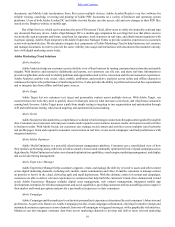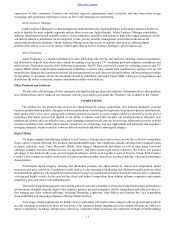Adobe 2015 Annual Report Download - page 20
Download and view the complete annual report
Please find page 20 of the 2015 Adobe annual report below. You can navigate through the pages in the report by either clicking on the pages listed below, or by using the keyword search tool below to find specific information within the annual report.
Table of Contents
20
conditions on us, our customers, suppliers and partners makes it difficult for us to forecast operating results and to make decisions
about future investments. If economic growth in countries where we do business slows, customers may delay or reduce technology
purchases, advertising spending or marketing spending. This could result in reductions in sales of our products and services, longer
sales cycles, slower adoption of new technologies and increased price competition. Our customers include government entities,
including the U.S. federal government, and if spending cuts impede the government’s ability to purchase our products and services,
our revenue could decline. Deterioration in economic conditions in any of the countries in which we do business could also cause
slower or impaired collections on accounts receivable, which may adversely impact our liquidity and financial condition.
A financial institution credit crisis could impair credit availability and the financial stability of our customers, including
our distribution partners and channels. A disruption in the financial markets may also have an effect on our derivative counterparties
and could also impair our banking partners, on which we rely for operating cash management. Any of these events would likely
harm our business, results of operations and financial condition.
Political instability in or around any of the major countries in which we do business would also likely harm our business,
results of operations and financial condition.
The increased emphasis on a cloud strategy may give rise to risks that could harm our business.
Over the past several years, our business has shifted away from pre-packaged creative software to focus on a subscription
model that prices and delivers our products and services in a way that differs from the historical pricing and delivery methods of
our creative tools and document services products. These changes reflect a significant shift from perpetual license sales and
distribution of our software in favor of providing our customers the right to access certain of our software in a hosted environment
or use downloaded software for a specified subscription period. This cloud strategy requires continued investment in product
development and cloud operations, and may give rise to a number of risks, including the following:
• if customers desire only perpetual licenses or to purchase or renew subscriptions for specific products rather than acquire
the entire Creative Cloud offering, our subscription sales may lag behind our expectations;
• our cloud strategy may raise concerns among our customer base, including concerns regarding changes to pricing over
time, service availability, information security of a cloud solution and access to files while offline or once a subscription
has expired;
• customers may turn to competitive or open-source offerings;
• we may be unsuccessful in maintaining our target pricing, new seat adoption and projected renewal rates; or we may
have to rely heavily on promotional rates to achieve target seat adoption, which could reduce average revenue per user;
and
• we may incur costs at a higher than forecasted rate as we expand our cloud operations.
We may be unable to predict subscription renewal rates and the impact these rates may have on our future revenue and operating
results.
The hosted business model we utilize in our Adobe Marketing Cloud offerings typically involves selling services on a
subscription basis pursuant to service agreements that are generally one to three years in length. Our individual Creative Cloud
and Document Cloud subscription agreements are generally month-to-month or one year in length, ETLAs for our Digital Media
products and services are generally three years in length, and subscription agreements for other products and services may provide
for shorter or longer terms. Our customers have no obligation to renew their subscriptions for our services after the expiration of
their initial subscription period, and some customers elect not to renew. We cannot provide assurance that our subscriptions will
be renewed at the same or higher level of service, for the same number of seats or licenses or for the same duration of time, if at
all. Moreover, under certain circumstances, some of our customers have the right to cancel their service agreements prior to the
expiration of the terms of their agreements. We cannot provide assurance that we will be able to accurately predict future customer
renewal rates. Our customers’ renewal rates may decline or fluctuate as a result of a number of factors, including their level of
satisfaction with our services, our ability to continue to regularly add features and functionality, the reliability (including uptime)
of our subscription services, the prices of our services, the actual or perceived information security of our systems and services,
the prices of services offered by our competitors, mergers and acquisitions affecting our customer base, reductions in our customers’
spending levels, or declines in customer activity as a result of economic downturns or uncertainty in financial markets. If our
customers do not renew their subscriptions for our services or if they renew on terms less favorable to us, our revenue may decline.
Our future growth is also affected by our ability to sell additional features and services to our current customers, which
depends on a number of factors, including customers’ satisfaction with our products and services, the level of innovation reflected
























